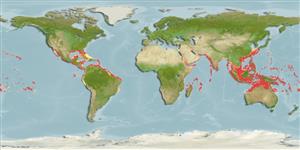Common names from other countries
Environment: milieu / climate zone / depth range / distribution range
Écologie
marin; océanodrome (Ref. 51243); profondeur 1 - 300 m (Ref. 58302). Deep-water; 31°N - 20°S (Ref. 4936)
Circumtropical. Western Indian Ocean: East Africa to India, between the Equator and 10°S, Mozambique Channel, Seychelles, and Madagascar. Eastern Indian Ocean: Indonesia (Ref. 5978) and Western Australia (Ref. 49596). Western Atlantic: Florida and northern Gulf of Mexico in USA to Brazil (Ref. 7251). Eastern Atlantic: 20°N to 20°S (Ref. 4936). Eastern Pacific: Guatemala to Peru (Ref. 9282) and Chile (Ref. 27363).
Length at first maturity / Taille / Poids / Âge
Maturity: Lm ?, range 17 - ? cm
Max length : 22.5 cm SL mâle / non sexé; (Ref. 45034)
Épines dorsales (Total) : 0; Rayons mous dorsaux (Total) : 32 - 35; Épines anales: 0; Rayons mous anaux: 25 - 28; Vertèbres: 39 - 43. Pectoral fins situated relatively low on body in juveniles. The distance between the base of the lowermost pectoral ray and the pelvic fin insertion less than 42% of head length (Ref. 559).
Found near the edge of the continental shelf. Appears to spawn all year-round. Marketed fresh, and eaten fried.
An intermittent multiple spawner.
Gomes, J., 1990. Bramidae. p. 758-764. In J.C. Quero, J.C. Hureau, C. Karrer, A. Post and L. Saldanha (eds.) Check-list of the fishes of the eastern tropical Atlantic (CLOFETA). JNCT, Lisbon; SEI, Paris; and UNESCO, Paris. Vol. 2. (Ref. 4936)
Statut dans la liste rouge de l'IUCN (Ref. 130435)
CITES (Ref. 128078)
Not Evaluated
Menace pour l'homme
Harmless
Utilisations par l'homme
Pêcheries: commercial
Outils
Articles particuliers
Télécharger en XML
Sources Internet
Estimates based on models
Preferred temperature (Ref.
115969): 18.7 - 28.2, mean 25.9 (based on 1189 cells).
Phylogenetic diversity index (Ref.
82804): PD
50 = 0.5039 [Uniqueness, from 0.5 = low to 2.0 = high].
Bayesian length-weight: a=0.01820 (0.00782 - 0.04232), b=2.96 (2.76 - 3.16), in cm Total Length, based on LWR estimates for this (Sub)family-body shape (Ref.
93245).
Niveau trophique (Ref.
69278): 3.8 ±0.6 se; based on size and trophs of closest relatives
Résilience (Ref.
120179): Haut, temps minimum de doublement de population inférieur à 15 mois (Preliminary K or Fecundity.).
Fishing Vulnerability (Ref.
59153): Low vulnerability (17 of 100).
